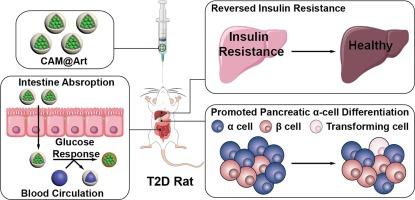口服葡萄糖反应纳米颗粒负载青蒿素诱导胰腺β细胞再生治疗2型糖尿病。
IF 9.7
1区 化学
Q1 CHEMISTRY, PHYSICAL
引用次数: 0
摘要
2型糖尿病(T2D)是一种以长期胰岛素抵抗(IR)和胰腺β细胞功能障碍为特征的慢性疾病。传统的T2D药物忽略了胰腺β细胞的损伤。在这项研究中,我们设计了一种口服葡萄糖反应纳米颗粒用于胰腺β细胞再生和治疗T2D。它是由以3-氨基苯基硼酸(APBA)为外壳接枝的羧甲基壳聚糖(CMC)和以硼酸酯键连接的包覆青蒿素(Art)的小分子柑橘果胶(MCP)球构成的。制备的CMC-APBA包覆的art -负载MCP纳米颗粒(CAM@Art)在体外实验中具有治疗IR、抗氧化和促进胰腺α-细胞分化的作用。此外,体内实验表明CAM@Art可以降低糖尿病大鼠的血糖、氧化应激和炎症水平,逆转IR。重要的是,在体内胰岛中发现了胰腺β细胞再生。从机制上讲,CAM@Art通过促进转录因子Pax4的过表达和Arx的异位表达来促进胰腺α-细胞分化。结果表明,本研究为糖尿病胰腺β细胞功能障碍的治疗提供了一种有希望的治疗策略。本文章由计算机程序翻译,如有差异,请以英文原文为准。

Oral glucose-responsive nanoparticles loaded with artemisinin induce pancreatic β-cell regeneration for the treatment of type 2 diabetes
Type 2 diabetes (T2D) is a chronic disease characterized by long-term insulin resistance (IR) and pancreatic β-cell dysfunction. Conventional T2D medication ignores pancreatic β-cell damage. In this study, we designed an oral glucose-responsive nanoparticle for pancreatic β-cell regeneration and treatment of T2D. It was formed by carboxymethyl chitosan (CMC) grafted with 3-aminophenylboronic acid (APBA) as the shell and small-molecule citrus pectin (MCP) spheres encapsulating artemisinin (Art) connected by borate ester bonds. The prepared CMC-APBA wrapped Art-loaded MCP nanoparticles (CAM@Art) had therapeutic effects for the treatment of IR, antioxidant and promotion of pancreatic α-cell differentiation in vitro experiments. In addition, in vivo experiments showed that CAM@Art could reduce blood glucose, oxidative stress and inflammation levels and reverse IR in diabetic rats. Importantly, pancreatic β-cell regeneration was found in islets in vivo. Mechanistically, CAM@Art promotes pancreatic α-cell differentiation by promoting overexpression of the transcription factor Pax4 and ectopic expression of Arx. The results suggest that the present study provides a promising therapeutic strategy for the treatment of diabetic pancreatic β-cell dysfunction.
求助全文
通过发布文献求助,成功后即可免费获取论文全文。
去求助
来源期刊
CiteScore
16.10
自引率
7.10%
发文量
2568
审稿时长
2 months
期刊介绍:
The Journal of Colloid and Interface Science publishes original research findings on the fundamental principles of colloid and interface science, as well as innovative applications in various fields. The criteria for publication include impact, quality, novelty, and originality.
Emphasis:
The journal emphasizes fundamental scientific innovation within the following categories:
A.Colloidal Materials and Nanomaterials
B.Soft Colloidal and Self-Assembly Systems
C.Adsorption, Catalysis, and Electrochemistry
D.Interfacial Processes, Capillarity, and Wetting
E.Biomaterials and Nanomedicine
F.Energy Conversion and Storage, and Environmental Technologies

 求助内容:
求助内容: 应助结果提醒方式:
应助结果提醒方式:


